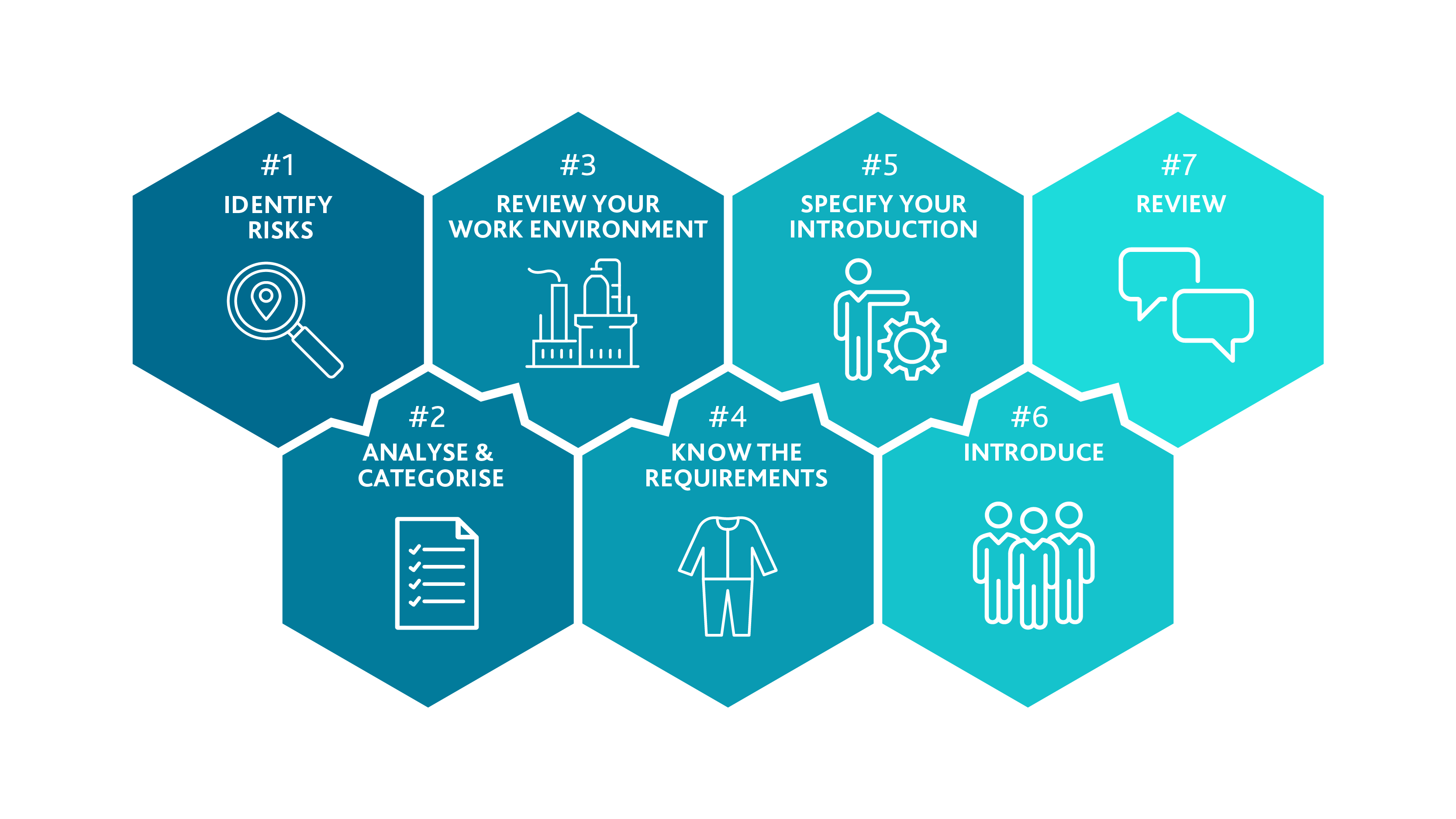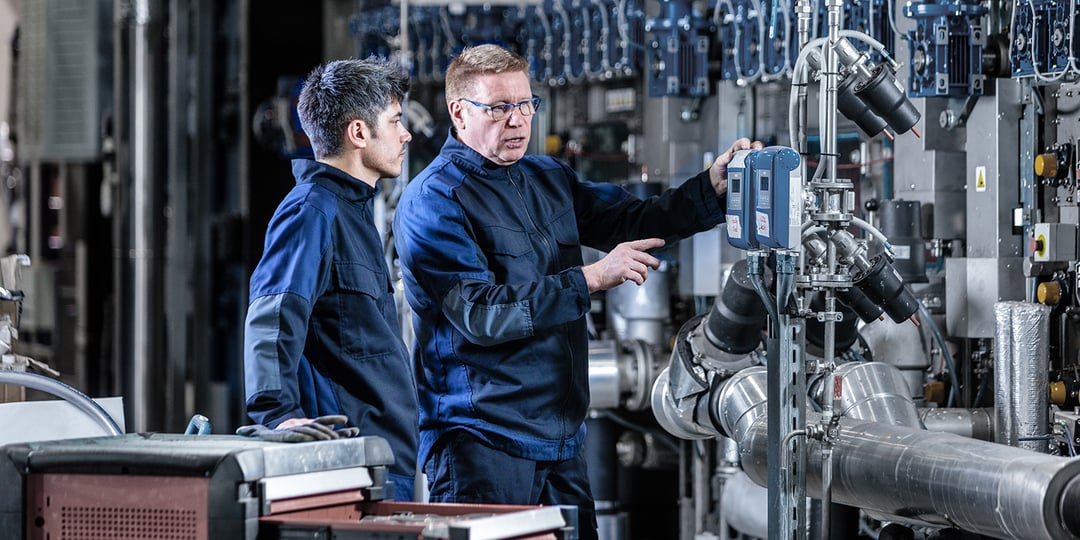The most important question that needs to be answered when selecting new protective clothing is the following: which risks are your workers exposed to and what kind of protection would provide the best solution? In order to recognize relevant safety risks, it is a necessity to conduct a risk assessment before selecting protective clothing.
Your company has rules and regulations to comply with in regards to the protection of your workers, which you cannot afford to neglect. But how do you make sure you conduct this process as efficiently as possible and don’t skip important steps? Find out how to conduct a risk assessment in 7 clear steps, provided by safety expert Jos Putman.
Jos Putman, safety expert at his own consultancy firm Veiligheidskundig Adviesbureau Putman with more than 40 years of experience as a Health & Safety and Quality Manager is formally retired, but he “couldn’t let go of this interesting profession”. Thanks to his valuable knowledge, we developed a roadmap towards the ideal risk assessment, which enables you to focus on the right things while selecting new protective clothing.
The 7 steps of a risk assessment
First, we would like to point out an ISO norm that provides generic guidelines and lays out a structure for risk assessments: ISO 31000. Read our previous blog to learn how the Framework Directive 89/391/EEC provides guidance for your risk assessment.
If you are looking for guidelines for your specific work environment, the SUCAM documents can be helpful. These documents help you with the Selection, Use, Care and Maintenance (SUCAM) of Personal Protective Equipment (PPE). In every SUCAM document, the risk assessment is part of the Selection process, which specifies focus points for a particular kind of PPE. For example, CEN/TR15419 contains guidelines for chemical protective clothing, while ISO/TR2801 does the same for flame retardant clothing.
ISO 31000 and the SUCAM documents show us that, in general, risk assessments can be broken down into 7 simple steps:
#1 - Identify the risk(s)
The first step is to identify possible risks in your work environment. Is protective clothing or other PPE necessary? If that is the case, in which kind of situations should it offer a certain level of protection? List the possible dangers of your work environment and identify the risks based on these dangers.
Bear in mind that every workstation and/or department is unique and has its own risks. This is why you should identify the risks separately per department to conduct a proper risk analysis.
#2 - Analyse and categorise these risks
Once you have a clear list of possible risks, you should then analyse and categorise them. Do this both quantitatively and qualitatively. Determine the magnitude of these risks with help of the Fine/Kinney Method. This method focuses on three parameters:
- Severity of injury linked to hazard
- Exposure to the hazard
- Probability of the hazard to occur when exposed
This way, the risk assessment will not only help you to identify possible risks, but will also form guidance on how to take further actions towards your protective clothing and how to categorise and prioritise them.
#3 - Review your current work environment
The third step is to analyse your current work environment and gain insight in the control measures that are active at the moment: what are the current safety protocols to secure the safety of your workers? Which kind of protective clothing are worn by workers? Answers to these questions should give you proper insight in the risks that already have been assessed.
Take into account that the standard directives are based on a standard work environment. We advise you to always look at unusual situations and environmental factors as well. For example: when activities take place outside, focus on possible extreme weather conditions while conducting the risk assessment.
#4 - Know your protective clothing requirements
If steps 1 to 3 are executed in the correct manner, you should now be able to identify the requirements of your future protective clothing. Common applications for protective clothing are:
- Protective clothing for welding (EN ISO 11611)
- Flame retardant clothing (EN ISO 11612)
- High visibility clothing (EN 20471)
- Protective clothing against chemicals (EN 13034)
- Protective clothing against arc flash (IEC 61482)
- Anti static clothing (EN1149-5)
Continue reading the following three steps, where we guide you through a complete and proper risk assessment.
#5 - Specify how to introduce the right protective clothing in your specific work environment
The previous steps focus on risks of the workfloor and certain standards your protective clothing should comply with. In this step, you are going to look beyond safety. This is where personal opinions and emotions come into play. Think about the workers’ wishes and expectations regarding comfort, durability, sustainability and design.
In this step, you examine the wishes and opinions of the workers, who will eventually wear the garments on the job. A protective clothing audit like PROCLAUD® helps you to properly assess these wishes and opinions.
When you know what your workers wants and needs are, sit down with the garment manufacturer in order to adapt the production process and design to meet your specific needs. In this phase it’s time to focus on practical questions that will help you determine how to introduce the protective clothing in your work environment in such a way that workers truly feel that their expectations are met.
Ask yourself: what are the necessary steps to accomplish this? After determining this, the garment manufacturer is able to create prototypes of the garments.
#6 - Introduce your new protective clothing
Now it is time to introduce your new protective workwear by using prototypes whilst conducting a wear trial. A wear trial allows workers to test the new protective clothing in practice and surfaces wishes or recommendations. Our experience learns that involving the garment manufacturer and your colleagues in wear trials can make a huge impact on the final garment.
The voice of the end user (your workers) is very important, because it will tell you if they like or dislike the garment. It shows the level of comfort, which directly effects the safety of your workers.
When people experience their garments as uncomfortable to wear, they might not wear it appropriate (or not at all). A garment can comply with all correct standards, but still be unsafe because it’s not being worn correctly. Therefore, comfort should always be taken into account.
If the your workers like wearing the new protective clothing and it ticks all the safety boxes, your risk assessment was a success. The order can now be finalised and the garment manufacturer can start the full production process. But that is not the last step!
#7 - Review frequently
For the safest work environment, it is important to assess the risks of your work environment periodically to make sure your protective clothing still meets the requirements. Determine a fixed period for the next assessment, for example once per year.
Are new safety measures needed? Is there a product innovation on the market that can help increase safety, comfort or durability of the fabric? Use these reviews to stay up to date on possible innovations, and assess if (and when) your protective clothing should be improved.
Teamwork makes safety work
Now you know how to conduct a risk assessment so you can boost your safety culture. Bear in mind that you are not alone in this. Make sure to involve the right expertise at the right time while conducting your risk assessment. For example, if your workers work with dangerous substances like chemicals, an occupational hygienist can help maintain your workplace safe by identifying, evaluating and controlling chemical exposure and accessory hazards.
In short, a risk assessment helps you to map safety risks of your workspace and tackle these issues upfront, before you select new protective clothing. Curious what the selection process of protective clothing looks like in practice?
Damen Shipyards Group also faced specific challenges while selecting their new protective clothing, like securing comfort of garments and being cost-efficient. By working together with several experts within the protective clothing value chain, they successfully selected protective clothing that perfectly suits their organisation. Read the story here.



![DAMEN case [EN]](https://eu.tencatefabrics.com/hs-fs/hubfs/EU%20-%20Images%20website/EU%20-%20Mock-up%20nieuwe%20afmetingen/DAMEN%20case%20%5BEN%5D.png?width=170&name=DAMEN%20case%20%5BEN%5D.png)



.png?width=399&name=Risk%20management%20for%20PPE%20clothing%20in%20the%20EV%20and%20battery%20industries%20(5).png)
